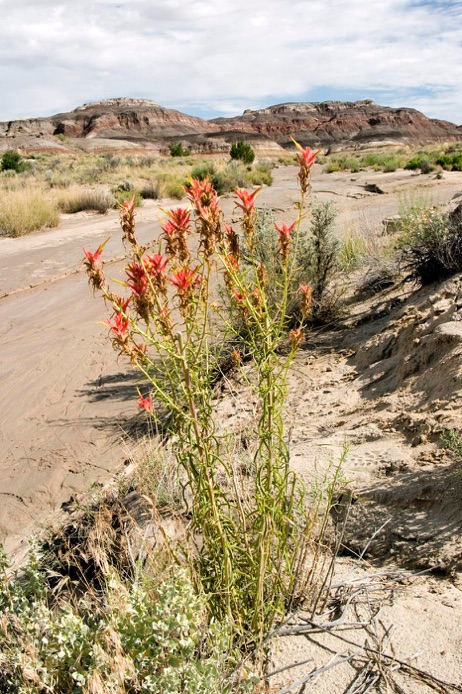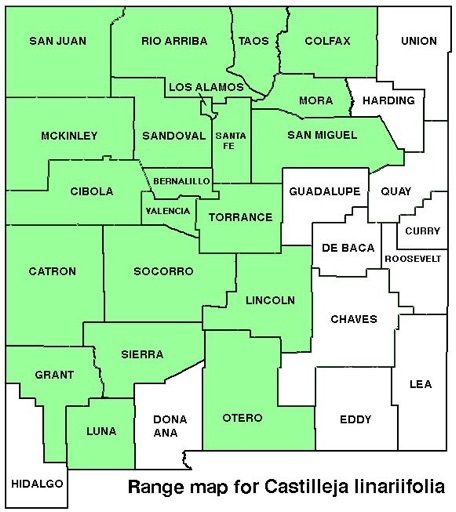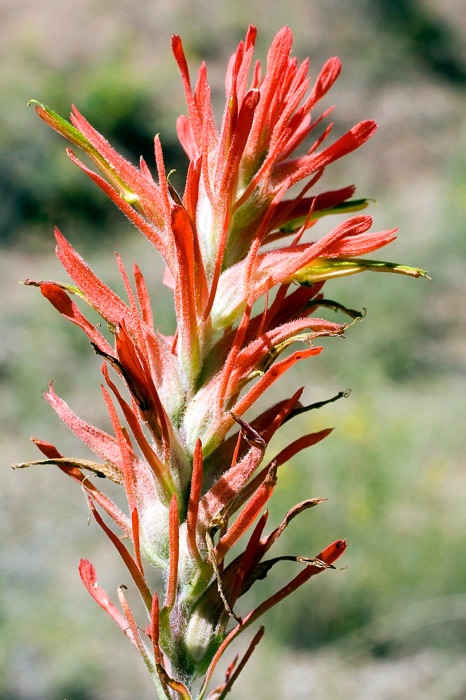WILDFLOWERS OF NEW MEXICO

Unlike most paintbrushes, this large-scale species reaches 3 1/2-feet tall (1 m) with multiple stems and showy spikes of flowers with red to orangish bracts. The stems are hairless or with short hairs, and gray-green aging to purplish-red. Note the narrow leaves roll inward along midrib, and the small, beak-like, bright-green flowers extend considerably beyond the red bracts. Though the leaves photosynthesize, the roots are parasitic, usually on shrubby species of sagebrush, Artemisia species.
FLOWERS: April–October. A loose spike 2–8-inches (5–20 cm) long with short, woolly hairs is lined with flowers with red or red-tipped bracts 5/8–1 1/4-inches (15–30 mm) long, lance-shaped, and with 3 narrow lobes; the green, beak-like flower has a red margin and extends 3/8–1 inch (10-24 mm) beyond the red sepal tube (calyx) and bracts.
LEAVES: Alternate. Linear, narrow, 3/4–2 3/8-inches (2–6 cm) long, unlobed or upper ones with 2–3 narrow lobes; margins often curl inward, surfaces mostly hairless.
HABITAT: Dry plains, sagebrush scrub, pinyon-juniper, ponderosa, fir-aspen forests.
Elevation 4,300–10,450 feet (1319–3165 m).
RANGE: Widespread in Rocky Mountain states and westward. State flower of Wyoming.
SIMILAR SPECIES: About 21 species of paintbrush in NM. The clumps of tall, reddish stems and narrow, linear leaves help identify this species.
NM COUNTIES: Dry mid-elevation habitats in the western 2/3 of NM: Bernalillo, Catron, Cibola, Colfax, Grant, Lincoln, Los Alamos, Luna, McKinley, Mora, Otero, Rio Arriba, San Juan, San Miguel, Sandoval, Santa Fe, Sierra, Socorro, Taos, Torrance, Valencia.









WYOMING PAINTBRUSH
CASTILLEJA LINARIIFOLIA
Broomrape Family, Orobanchaceae (formerly in Scrophulariaceae, Snapdragon Family)
Perennial hemiparasitic herb



























THE CONTENTS OF THIS WEBSITE ARE COPYRIGHTED AND CANNOT BE USED
WITHOUT PERMISSION OF GEORGE OXFORD MILLER


























-
1.Pointed green flower with red margin (upper arrow) extends beyond red sepal tube (calyx) (middle arrow).
-
2.Woolly, red or red-tipped bracts with 3 narrow lobes (lower arrow).




















EMAIL ME







